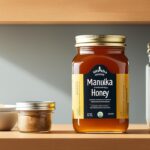For centuries, the quest for natural healing has led to the discovery of various remedies, but few have stood the test of time like manuka honey. This exceptional substance has not only claimed its rightful place in the realm of wound care but has also emerged as a symbol of gentle treatment with potent antibacterial properties. The secret to its efficacy lies in its rich history and the meticulous research that backs its ability to facilitate tissue repair and treatment of wounds.
Recent studies illuminate manuka honey’s remarkable capacity to heal nonhealing discharging wounds, offering patients a soothing, yet powerful option for recovery. Its anti-inflammatory qualities and ability to promote autolytic debridement mean that wounds are not only cleansed but nurtured towards complete healing. As a result, individuals are finding a reliable and comforting ally in manuka honey dressings, even in an era dominated by synthetic pharmaceuticals.
Incorporating manuka honey into modern medical practice continues as it exceeds expectations with its minimal side effects and non-invasive nature, signaling a resurgence in the integration of nature’s pharmacy into wound care therapies. Welcome to a world where traditional knowledge meets cutting-edge science, and witness the transformative power of manuka honey in wound healing.
The Historical Use of Honey in Medicine
The profound relationship between honey and healing is as old as history itself, with ancient treatments heavily featuring honey for its curative properties. Spanning over four millennia, natural remedies have embraced honey, particularly for its effectiveness in wound healing and infection treatment. With the dawn of scientific inquiry in the late 19th century, these ancient practices were validated as honey’s antibacterial qualities came to light. Among the many varieties of honey, Manuka, derived from the Leptospermum scoparium bush, stands out for its exceptional attributes in the medical world.
- Ancient civilizations including the Egyptians, Greeks, and Romans used honey as a standard remedy for treating wounds and diseases.
- Ayurvedic medicine, a traditional Indian system of treatment, has consistently employed honey for its enzymatic healing benefits.
- References in religious texts highlight honey’s divine stature, often regarded as a potent medicine.
By documenting its use throughout the ages, honey’s place in the annals of medicinal history has been firmly established. In particular, Manuka honey’s rise to prominence is owed to literature reviews that celebrate its special healing properties. This venerable product of nature is more than a sweetener—it’s a testament to the enduring legacy of the history of honey in healing.
Manuka Honey: An Overview and its Unique Origins
The enigmatic journey of Manuka honey, from the rugged terrains of New Zealand and the untouched wilderness of South East Australia, hinges on the extraordinary Leptospermum scoparium, more commonly referred to as the Manuka bush. Deriving its luxurious and healing nectar, which creates Manuka honey, this mono-floral variety is replete with properties that have captivated the world. Notably, the unique manuka factor is a quintessential measure that sets this honey apart from others, attributing its fame to the presence of potent compounds imbued with remarkable antibacterial prowess.
- Methylglyoxal (MGO): A compound directly influencing the honey’s antibacterial strength, found in higher concentrations in Manuka honey.
- Dihydroxyacetone (DHA): Found in the nectar of Manuka flowers that eventually converts into MGO during the honey production process.
- Leptosperin: An additional marker unique to Manuka honey, guaranteeing authenticity and the presence of specific natural attributes.
It’s this unique synergy of elements that grants Manuka honey its coveted status. The guardianship of Manuka honey production reverberates through the verdant landscapes of New Zealand and Australia, where the meticulous process of harvesting intertwines with the meticulous stewardship of the land and its treasured Manuka bushes. Thus, ensuring the preservation and perpetuation of this golden elixir across generations.
In a marketplace replete with natural remedies, Manuka honey’s esteemed unique manuka factor is not only a stamp of excellence but also a beacon of the product’s authenticity and New Zealand’s proud heritage. As consumers globally seek out the purest forms of natural healing, Manuka honey stands tall as a testament to the power of nature’s gifts, carefully forged through the phenomenon that is Leptospermum scoparium.
Manuka Honey Wound Care Benefits
The natural healing properties of Manuka honey have been increasingly acknowledged in the realm of wound care. Various studies have shed light on its potential to not only reduce wound size but also to promote the overall healing process.
Notably, its role in wound epithelization is critical. As the body’s natural repair mechanism to close wounds, epithelization is crucial for maintaining tissue integrity and health. Manuka honey’s rich composition significantly aids this process, resulting in enhanced healing times and minimized scarring.
- Inflammation is the body’s innate response to injury, but excessive inflammation can impede healing. The anti-inflammatory properties of Manuka honey work to suppress inflammation, allowing for a calmer healing environment.
- Dock on the role Manuka honey plays in tissue growth promotion. Its bioactive compounds foster an environment that supports the growth of new tissue, crucial for healing particularly deep or otherwise troublesome wounds.
- Furthermore, this extraordinary substance has been associated with substantial pain relief. Its soothing properties help in dulling the pain often associated with wounds and burns.
Manuka honey’s multifaceted benefits make it a promising alternative or complement to traditional wound care practices. It is a powerhouse in fighting infection, reducing inflammation, and nurturing new tissue growth, all while providing a natural pain reliever for those recovering from various types of wounds.
Exploring the Antibacterial Properties of Manuka Honey
The profound impact of Manuka honey on antibacterial therapy has become increasingly evident in recent years. As scientists and medical professionals explore alternative treatments to combat antibiotic-resistant strains, the emergence of Manuka honey’s broad-spectrum antibacterial activity offers a glimmer of hope. It is particularly effective against the notorious methicillin-resistant Staphylococcus aureus (MRSA), a strain that has challenged healthcare systems worldwide due to its resistance to conventional antibiotics.
One of the most remarkable aspects of Manuka honey is its Unique Manuka Factor (UMF), which has shown to not only hinder the growth of bacterial colonies but also disrupt existing biofilms. This is especially significant considering that biofilms, which are protective layers created by bacteria like MRSA, are notoriously difficult to penetrate with standard antimicrobial agents. The ability of Manuka honey to overcome this barrier demonstrates its potent efficacy in in vivo bacterial challenges.

In addition to its prowess against MRSA, Manuka honey’s broad-spectrum capabilities extend to a variety of pathogens, including those responsible for oral infections and dermatitis. Its action against E. coli and other common germs further cements its status as an antimicrobial powerhouse. Furthermore, clinical trials have seen Manuka honey reduce dental plaque and alleviate symptoms of gingivitis, adding to its repertoire of health benefits.
- Combatting MRSA and other antibiotic-resistant strains
- Disrupting biofilms with the unique methylglyoxal compound
- Reducing dental plaque and signs of gingivitis
- Offering a natural alternative in the fight against various bacterial challenges
Understanding the full potential and applications of Manuka honey in combating resistant pathogens continues to be a promising field of study. Its broad-spectrum antibacterial activity, coupled with the Unique Manuka Factor, positions it as a valuable player in the future of infectious disease management.
Manuka Honey in Clinical Studies and Trials
The exploration of manuka honey in the medical field has contributed greatly to our understanding of wound management and infection control. Empirical clinical evidence obtained through scientific research solidifies its status as a beneficial agent in treating various wound types.
Recent studies have documented the efficacy of manuka honey against biofilm-associated infections. In particular, the following points have been made evident in clinical trials:
- Significantly reduces bacterial presence in wound sites by disrupting biofilms, leading to lowered infection rates and enhanced wound cleanliness.
- Exhibits accelerated healing properties, particularly in patients with burns and surgical wounds.
- Provides a protective barrier against inflammation in the esophagus during cancer treatments, such as radiation and chemotherapy.
- Offers a unique approach to antibacterial interventions that does not contribute to the growing concern of antibiotic resistance.
These findings align with the shift toward incorporating honey-based products in medical protocols, further asserting that manuka honey is more than just a traditional remedy—it’s a scientifically backed treatment that’s gaining credibility in the realm of modern medicine.
Application Methodology for Wound Care
Proper wound management is critical for effective healing. When it comes to utilizing wound dressing techniques involving medical grade honey, a meticulous treatment protocol must be followed to promote optimal outcomes.
- Carefully clean the wound with saline solution to ensure that all foreign materials and bacteria are removed.
- Apply a generous layer of sterilized, medical-grade Manuka honey to the wound site. The sterile preparation of the honey is crucial to prevent contamination and infection.
- Cover the honey dressed wound with a sterile bandage to maintain a moist environment conducive to healing.
- Change the dressing as prescribed by a medical professional, typically once a day or more often if the wound is heavily draining.
It’s essential to utilize honey that has been prepared under strict sterile conditions suitable for medical use, as typical store-bought honey is not appropriate for treating wounds due to potential impurities.
Medical practitioners often combine the use of medical grade Manuka honey with conventional antibiotics to address any potential infections, creating an integrated approach to wound care.
Factors Affecting the Efficacy of Manuka Honey on Wounds
The healing properties of Manuka honey are not uniform across all wounds, with several factors influencing its therapeutic impact. Understanding these nuances is crucial for medical professionals and patients aiming to optimize wound treatment outcomes.
One of the primary factors is wound acidity, an essential aspect of the wound-healing process. Manuka honey lowers the pH level of wounds, creating an acidic environment that is unfavorable for bacterial growth and promotes the wound healing process.
The osmotic effects of Manuka honey are also a key player in wound care. The high sugar content in honey leads to an osmotic gradient that draws moisture out from the wound, thereby assisting in lymphatic flow and helping to clean the wound, reduce edema, and inhibit the proliferation of microorganisms.
- Encouragement of nutrient-rich lymphatic fluid to the site of the wound.
- Reduction in swelling due to the removal of excess fluids.
- Decreased odor in chronic wounds.
In addition, the variety of bioactive compounds found in Manuka honey play a significant role. These include D-glucono-δ-lactone, a compound involved in the gradual acidification of honey, and other substances that have immunomodulatory effects on the wound site.
- Stimulation of the immune response.
- Enhanced antibacterial activity.
- Protection against wound infections.
However, healing rate variability amongst individuals can also impact the efficacy of Manuka honey in wound treatment. Patient-specific factors such as age, comorbidities, and nutritional status contribute to the healing rate and may affect the efficiency of Manuka honey as a wound care treatment.
Comparisons with Traditional Wound Care Methods
As we delve into the modern advancements in medical treatments, it’s crucial to understand how modern dressing materials stack up against traditional treatments in the context of wound healing times. The evolution of wound care has seen a shift from conventional gauze and bandages to hydrogels, alginates, and foams, which are designed to maintain a moist environment and promote healing. Yet, amidst these scientific innovations, manuka honey has emerged as a unique blend of tradition and modern science.

Despite manuka honey’s ancient roots, its effectiveness in contemporary medicine continues to be explored. Clinical comparisons have suggested promising outcomes, particularly when addressing mild burns and postoperative recovery. Here’s a brief overview of how manuka honey stands alongside traditional methodologies:
- Accelerated healing times have been observed with manuka honey in comparison to standard dressings for mild burns.
- Post-surgical wounds treated with manuka honey have reported reduced infection rates, suggesting a beneficial role in surgical wound management.
- The natural antibacterial properties inherent in manuka honey contribute to its possibly effective status in modern wound care protocols.
On the balance sheet of wound care, manuka honey is cataloged not just among modern dressing materials but also as a revival of traditional treatments. While its anecdotal history is rich, robust scientific research is necessary to cement its place in medical practice fully. By conducting further comparative studies, the medical community can better harness the potential of manuka honey to improve wound healing times and possibly reduce the reliance on traditional methods that are less efficient in today’s healthcare landscape.
Precautions and Considerations in Using Manuka Honey
Opting for Manuka honey’s therapeutic benefits in wound healing or to combat bacterial infections requires an awareness of certain precautions and considerations for individuals with underlying medical conditions, a propensity for allergic reactions, the necessity of diabetes management, and a possibility of medication interactions.
Be attentive to the following points:
- Individuals with a known allergy to bee products should avoid manuka honey as it may trigger allergic reactions.
- Due to its high sugar content, manuka honey can significantly impact blood sugar levels, necessitating careful monitoring for those managing diabetes.
- As with many natural remedies, manuka honey can have interactions with prescribed medications. Consulting with a healthcare provider is crucial to ensure it can be integrated safely into one’s treatment regimen.
- Finally, as manuka honey is a potent compound with a variety of active ingredients, it’s important for those with any pre-existing medical conditions to seek medical advice to confirm there’s no risk of adverse effects.
While manuka honey stands out for its healing prowess, a tailored approach to its use, considering personal health profiles, ensures its benefits can be enjoyed without compromising individual well-being.
Conclusion
The therapeutic properties of Manuka honey as a natural wound remedy can no longer be regarded as just an element of folklore or anecdotal evidence. The significant body of clinical studies that affirm the efficacy of Manuka honey in wound management is compelling, heralding a new era where natural remedies are standing alongside conventional medical applications. Its therapeutic repertoire that encompasses antibacterial, anti-inflammatory, and tissue repair capabilities renders it an invaluable tool in the medical practitioner’s arsenal.
While Manuka honey’s virtues in aiding natural healing are pronounced, it is essential to approach its use with due diligence, considering individual health concerns and seeking professional guidance. It is a testament to the need for a cautious harmony between natural remedies and modern medical oversight to optimize health outcomes. The remarkable features of Manuka honey, underscored by its historical legacy and scientific backing, highlight the sophistication of what may seem like a humble byproduct of nature.
As we look to the future, continued research is critical in elaborating the full spectrum of Manuka honey’s medicinal applications. The investigative journey could pave the way for Manuka honey to be more widely accepted in treating a broader range of health ailments within evidence-based medicine. The convergence of ancient wisdom with contemporary scientific rigor holds the promise of expanding our healing modalities and enriching our conception of integrated healthcare. The journey of Manuka honey, from indigenous forests to clinical settings, continues to inspire a world where natural goodness and scientific innovation create a synergy for the betterment of health and healing.




